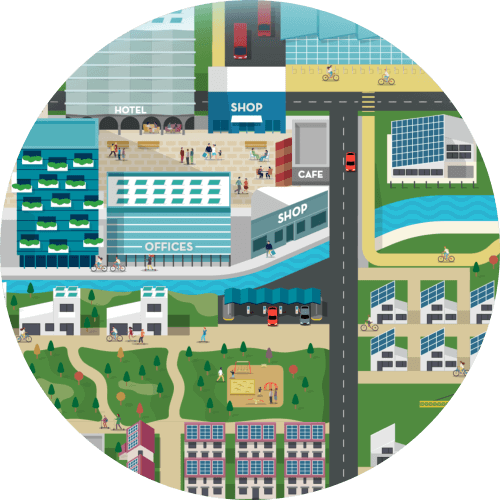Se de steg ditt företag kan ta mot en mer hållbar framtid genom våra öppna resurser.
Switching to Renewable Electricity
Introduction
This guide focuses on how to transition to renewable energy sources. It focuses on electricity, but you should also consider other types of energy use – such as heating, cooling, and steam – depending on the nature of your business.
Solutions already exist to halve emissions from this sector by 2030, and by 2050, it’s feasible that 90% of global electricity could come from renewable sources. Making the switch to renewable energy in your business is the climate solution with perhaps the greatest impact on emissions, making it a vital part of aligning your organisation with the goal of keeping global heating below 1.5°C.
Remember that reducing energy use is an important step – not only will it reduce emissions, but it will also lower costs. So, regularly monitor your energy usage and look for savings and efficiency opportunities. Check for government advice or incentives that can help you make this transition and boost energy efficiency – there may be grants, tax rebates and other schemes available to reduce the up-front costs. See our other guides for more guidance on how to reduce energy usage from your operation.
If you rent buildings and energy is included in your lease agreement, inquire if your landlord uses renewable energy. If they don’t, request that they make the switch.
Measure and Understand
Start by working out your annual consumption of each different type of energy you use (electricity, district heating, fossil gas, steam, district cooling). This is information that can be provided by your suppliers. Use a smart meter to collect data on the energy use by your organisation, and consider how it may change in the coming years. Knowing your usage is essential as supplier options and prices often depend on volume.
Energy delivered through grids is typically measured and sold in kWh. So, to track your progress in switching to renewables, look at the percentage of your purchased energy (in kWh) that comes from renewable sources.
Key Actions
On-Site Renewable Energy Generation
If possible, install renewable energy sources at your location, or encourage your landlord to do so. Of course, this may not be feasible for all organisations and probably won’t cover all your electricity needs. See our guide on installing renewable energy for more information. Find case studies on how SMEs have done this at our learning tool Climate Fit: Climate Action for your operations.
Power Purchase Agreements
The next best option is a long-term (10-15 years) power purchase agreement (PPA) with a renewable energy project developer. This supports renewable energy growth. PPAs are a significant commitment. PPAs are a significant commitment and it is therefore crucial to fully understand the terms and potential impacts on your budget. For smaller companies, teaming up with others to acquire an ”aggregated” PPA can reduce costs and protect against price volatility (see guidance on PPAs here and aggregated PPAs here).
Green Tariffs
Many companies find it easiest to switch to a green tariff from an energy supplier. These are contracts supplying energy tagged with renewable energy certificates. Contact multiple suppliers to ask about their green tariffs, compare prices, and understand how they differ. If comparing the options is overwhelming due to the size or nature of your organisation, you may choose to get assistance from an energy broker.
Be aware that green tariffs from different suppliers vary in their actual ”greenness” Some energy companies generate power from fossil fuels and buy surplus renewable certificates. Choose a tariff with a supplier that:
- Produces only 100% renewable energy
- Can supply your organisation with 100% renewable energy, matching all purchased kWh/MWh with renewable energy certificates
- Buys renewable energy from sites they own or are in your country, using certificates from the same sites
To verify a green tariff’s ”greenness”, ask for the supplier’s annual fuel mix disclosure (100% renewables is optimal) and for information about where the renewable certificate comes from. You can also look for quality labels like Green-e in the USA, and EKO energy.
Engage with Employees
Switching to renewable energy becomes simpler with lower energy use. Encourage your team to find ways to cut energy consumption across your operations, including for your buildings, IT equipment, data storage, and more.
Not sure how to start?
See the steps you can take and get help building a plan to cut your business emissions today.
¿No estás seguro de por dónde empezar?
Revisa los pasos que puedes dar y obtén ayuda para elaborar un plan para reducir las emisiones de tu empresa hoy mismo.
لست متأكداً كيف تبدأ؟
اطلع على الخطوات التي يمكنك اتخاذها واحصل على المساعدة في وضع خطة لخفض انبعاثات شركتك اليوم.
Vous ne savez pas par où commencer ?
Découvrez les mesures que vous pouvez prendre et obtenez de l’aide pour élaborer un plan pour réduire les émissions de votre entreprise dès aujourd’hui.
Ready to commit to lower emissions?
It’s easy to make the commitment. Just complete a form sharing your intent to reduce your emissions.
You’ll earn public recognition for taking the first step.
¿Listo para comprometerte a reducir tus emisiones?
Es fácil comprometerse. Solo tienes que completar un formulario compartiendo tu intención de reducir tus emisiones.
Ganarás reconocimiento público por tomar este primer paso.
هل أنت مستعد للالتزام بتقليل الانبعاثات؟
الالتزام سهل. ما عليك سوى تعبئة نموذج لمشاركة عزمك على تقليل انبعاثاتك.
سوف تحظى باعتراف عام باتخاذك الخطوة الأولى.
Prêt à vous engager pour réduire les émissions ?
S’engager est simple. Il suffit de remplir un formulaire indiquant votre intention de réduire vos émissions.
Vous gagnerez une reconnaissance publique pour avoir fait le premier pas.
Register now to use our tools
Register now to use our tools

Håll dig uppdaterad!
Anmäl dig till vårt nyhetsbrev för att hålla dig uppdaterad med de senaste klimatutvecklingarna.
Logga in
Don't have an account? Create account to access our tools or make the SME Climate Commitment
Logga in
Don't have an account? Create account to access our tools or make the SME Climate Commitment
Logga in
Don't have an account? Create account to access our tools or make the SME Climate Commitment
Forgot password?
Please enter your email address. You will receive a link to create a new password via email.

 Go back
Go back


 Action Space landing page
Action Space landing page